Using other driving systems
Cruise control
Use cruise control to maintain a set speed without depressing the
accelerator
pedal.
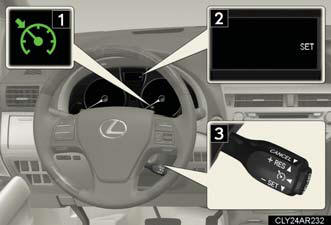
1. Indicator.
2. Display.
3. Cruise control switch.
Setting the vehicle speed
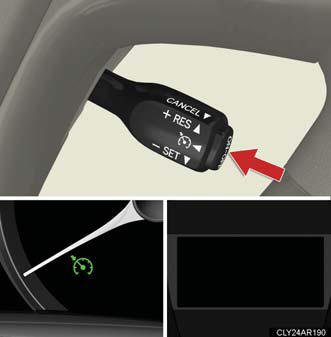
Press the “ON-OFF” button to
activate the cruise control.
Press the button again to deactivate
the cruise control.
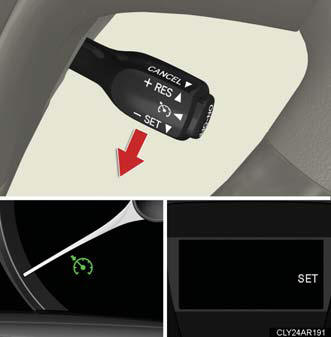
Accelerate or decelerate to the
desired speed, and push the
lever down to set the speed.
“SET” will be displayed.
Adjusting the set speed
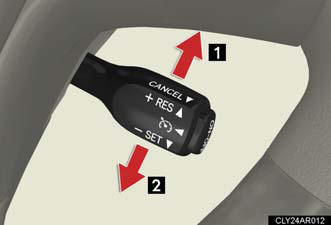
1. Increases the speed.
2. Decreases the speed.
Hold the lever until the desired
speed setting is obtained.
Fine adjustment of the set speed
can be made by lightly pushing
the lever up or down and releasing
it.
Canceling and resuming the constant speed control
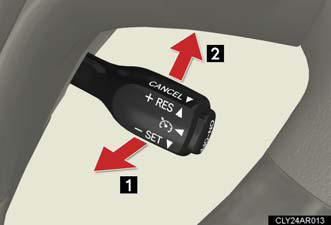
1. Pulling the lever towards you
cancels the constant speed
control.
The speed setting is also canceled
when the brakes are
applied.
2. Pushing the lever up resumes
the constant speed control.
Cruise control can be set when
l The shift lever is in D or “4”, “5” or “6” range of S has been selected.
Vehicle speed is above 25 mph (40 km/h).
Accelerating
The vehicle can be accelerated normally. After acceleration, the set speed
resumes.
Automatic cruise control cancelation
Cruise control will stop maintaining the vehicle speed in any of the
following situations:
Actual vehicle speed falls more than 10 mph (16 km/h) below the preset vehicle
speed.
At this time, the memorized set speed is not retained.
Actual vehicle speed is below 25 mph (40km/h).
VSC is activated.
If the cruise control indicator light flashes
Press the “ON-OFF” button once to deactivate the system, and then press the
button
again to reactivate the system.
If the cruise control speed cannot be set or if the cruise control cancels
immediately
after being activated, there may be a malfunction in the cruise control system.
Have
the vehicle inspected by your Lexus dealer.
CAUTION:
To avoid operating the cruise control by mistake
Switch the cruise control off using the “ON-OFF” button when not in use.
Situations unsuitable for cruise control
Do not use cruise control in any of the following situations.
Doing so may result in loss of control and could cause an accident resulting in
death
or serious injury.
In heavy traffic
On roads with sharp bends.
On slippery roads, such as those covered with rain, ice or snow.
On winding roads.
On steep hills.
Vehicle speed may exceed the set speed when driving down a steep hill.
When your vehicle is towing anything.
Dynamic radar cruise control
Dynamic radar cruise control supplements conventional cruise control
with a vehicle-to-vehicle distance control. In vehicle-to-vehicle distance
control mode, the vehicle automatically accelerates or decelerates in
order to maintain a set following distance from vehicles ahead.
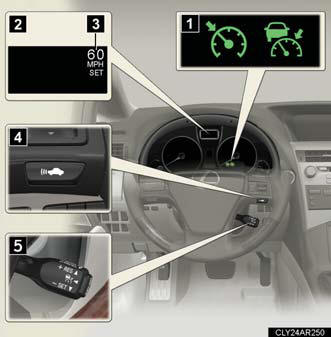
1. Indicators.
2. Display.
3. Set speed.
4. Vehicle-to-vehicle distance
button.
5. Cruise control switch.
Setting the vehicle speed (vehicle-to-vehicle distance control
mode)
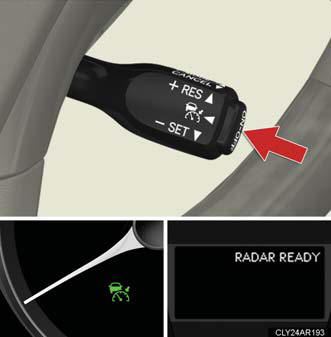
Press the “ON-OFF” button to
activate the cruise control.
Press the button again to deactivate
the cruise control.
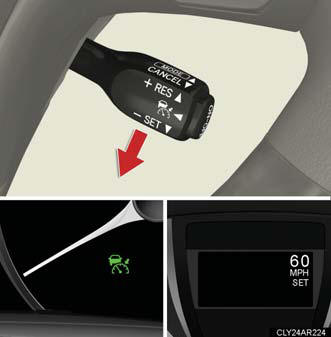
Accelerate or decelerate the
vehicle to the desired speed,
and push the lever down to set
the speed.
“SET” will be displayed.
Adjusting the set speed
To change the set speed, operate the lever until the desired set
speed is displayed.
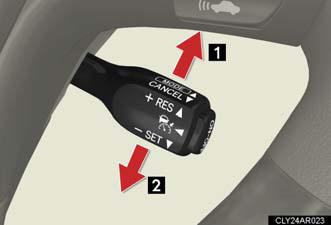
1. Increases the speed.
2. Decreases the speed.
Fine adjustment: Momentarily
move the lever in the desired
direction.
Large adjustment: Hold the
lever in the desired direction.
In the vehicle-to-vehicle distance control mode, the set speed will be
increased or decreased as follows:
- When the set speed is shown in “MPH”.
Fine adjustment: By approximately 1 mph (1.6 km/h) each time the lever is
operated.
Large adjustment: By approximately 5 mph (8 km/h) for each 0.75 seconds
the lever is held.
- When the set speed is shown in “km/h”.
Fine adjustment: By approximately 0.6 mph (1 km/h) each time the lever is
operated.
Large adjustment: By approximately 3.1 mph (5 km/h) for each 0.75 seconds
the lever is held.
In the constant speed control mode, the set speed will be
increased or decreased as follows:
Fine adjustment: By approximately 1 mph (1.6 km/h) each time the lever is
operated.
Large adjustment: The set speed can be increased or decreased continually
until the lever is released.
Changing the vehicle-to-vehicle distance
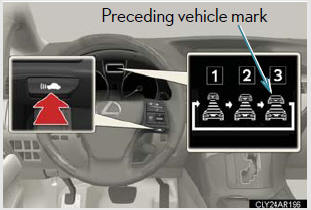
Pressing the button changes the
vehicle-to-vehicle distance as
follows:
1. Long.
2. Medium.
3. Short.
The vehicle-to-vehicle distance
is set automatically to long
mode when the “POWER”
switch is turned to ON mode.
If a vehicle is running ahead of
you, the preceding vehicle mark
will also be displayed.
Canceling and resuming the speed control
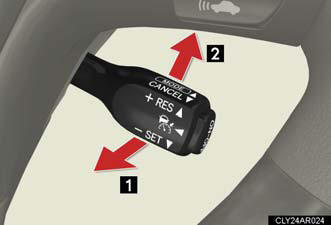
1. Pulling the lever toward you
cancels the cruise control.
The speed setting is also canceled
when the brakes are
applied.
2. Pushing the lever up resumes
the cruise control and returns
vehicle speed to the set
speed.
Resuming is available when the
vehicle speed is more than
approximately 25 mph (40 km/
h).
Driving in vehicle-to-vehicle distance control mode
This mode employs a sensor to detect the presence of vehicles up to
approximately 400 ft. (120 m) ahead and to judge the distance between
your vehicle and those the vehicle ahead of you.
Note that vehicle-to-vehicle distance will close in when traveling on long
downhill slopes.
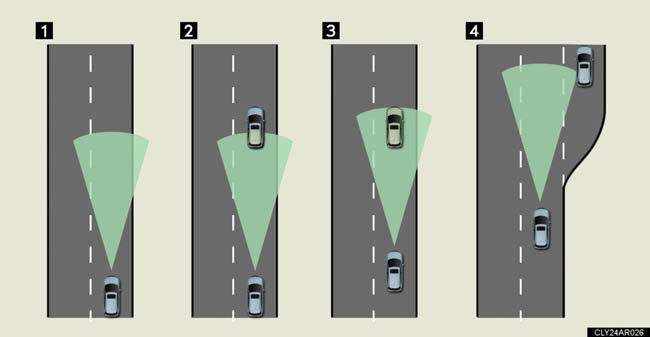
1. Example of constant speed cruising.
When there are no vehicles ahead.
The vehicle travels at the speed set by the driver. The desired
vehicle-to-vehicle
distance can also be set by operating the vehicle-to-vehicle distance control.
2. Example of deceleration cruising.
When the vehicle ahead is driving slower than the set speed.
When a vehicle is detected running ahead of you the system automatically
decelerates your vehicle. When a greater reduction in vehicle speed is
necessary,
the system applies the brakes. A warning tone warns you when the
system cannot decelerate sufficiently to prevent your vehicle from closing in
on the vehicle ahead.
3. Example of follow-up cruising.
When following a vehicle driving slower than the set speed.
The system continues follow-up cruising while adjusting for changes in the
speed of the vehicle ahead in order to maintain the vehicle-to-vehicle distance
set by the driver.
4. Example of acceleration.
When there are no longer any vehicles driving slower than the set
speed.
The system accelerates until the set speed is reached. The system then
returns to constant speed cruising.
Approach warning
When your vehicle is too close to a vehicle ahead, and sufficient automatic
deceleration via the cruise control is not possible, the display will
flash and the buzzer will sound to alert the driver. An example of this
would be if another driver cuts in front of you while you are following a
vehicle. Apply the brakes to ensure an appropriate vehicle-to-vehicle distance.
Selecting conventional constant speed control mode
Dynamic radar cruise control can be used as conventional cruise control
if you select constant speed control mode.
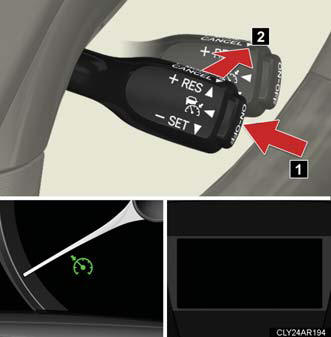
1. Press the “ON-OFF” button to
activate the cruise control.
Press the button again to deactivate
the cruise control.
Vehicle-to-vehicle distance control
mode is always reset when the
“POWER” switch is turned to ON
mode.
2. Switch to constant speed control
mode.
(Push the lever forward and
hold for approximately one second.)
Constant speed control mode indicator
will come on.
Dynamic radar cruise can be set when
The shift lever is in the D or range “4” or higher of S has been selected.
Vehicle speed is above approximately 30 mph (50 km/h).
Switching modes
The mode cannot be switched to constant speed control mode if
vehicle-to-vehicle
distance control mode has been used. The mode also cannot be switched from
constant speed control to vehicle-to-vehicle distance control mode. Turn the
system
off by pressing the “ON-OFF” button, and turn it on again.
Accelerating
The vehicle can accelerate normally. After acceleration, the set speed
resumes.
However, during vehicle-to-vehicle distance control mode, the vehicle speed may
decrease below the set speed in order to maintain the distance to the vehicle
ahead.
Automatic cancelation of vehicle-to-vehicle distance control
Vehicle-to-vehicle distance control driving is automatically canceled in the
following
situations:
Actual vehicle speed falls below approximately 25 mph (40 km/h).
VSC is activated.
The sensor cannot operate correctly because it is covered in some way.
The windshield wipers are operating at high speed.
When the snow mode is set.
If vehicle-to-vehicle distance control driving is automatically canceled for any
other
reason, there may be a malfunction in the system. Contact your Lexus dealer.
Automatic cancelation of constant speed control
The cruise control will stop maintaining the vehicle speed in the following
situations:
Actual vehicle speed is more than approximately 10 mph (16 km/h) below the
set vehicle speed.
At this time, the memorized set speed is not retained.
Vehicle speed falls below approximately 25 mph (40 km/h).
VSC is activated.
Vehicle-to-vehicle distance settings
Select a distance from the table below. Note that the distances shown
correspond
to a vehicle speed of 50 mph (80 km/h). Vehicle-to-vehicle distance increases/
decreases in accordance with vehicle speed.

Radar sensor and grille cover
Always keep the sensor and grille cover clean to ensure that the
vehicle-to-vehicle
distance control operates properly. (Some obstructions, such as snow, ice and
plastic
objects, cannot be detected by the obstruction sensor.)
Dynamic radar cruise control is canceled if an obstruction is detected.
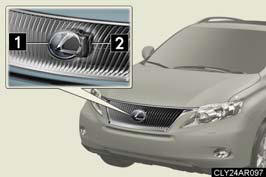
1. Grille cover.
2. Radar sensor.
Warning lights, messages and buzzers for dynamic radar cruise control
Warning lights, messages and buzzers are used to indicate a system
malfunction or
to inform the driver of the need for caution while driving.
Approach warning
In the following instances, there is a possibility that warnings will not
occur:
When the speed of the vehicle ahead matches or exceeds your vehicle speed.
When the vehicle ahead is traveling at an extremely slow speed.
Immediately after the cruise control speed was set.
At the instant the accelerator is applied.
Certification
- For vehicles sold in U.S.A.
FCC ID: HYQDNMWR005.
This device complies with Part 15 of the FCC Rules. Operation is subject to the
following
two conditions: (1) this device may not cause harmful interference, and (2)
this device must accept any interference received, including interference that
may
cause undesired operation.
FCC WARNING
Changes or modifications not expressly approved by the party responsible for
compliance could void the user’s authority to operate the equipment.
Radio frequency radiation exposure Information:
This equipment complies with FCC radiation exposure limits set forth for an
uncontrolled
environment.
This equipment should be installed and operated with minimum distance of 20 cm
between the radiator and your body.
This transmitter must not be co-located or operating in conjunction with any
other
antenna or transmitter.
- For vehicles sold in Canada.
Operation is subject to the following two conditions: (1) this device may not
cause
interference, and (2) this device must accept any interference, including
interference
that may cause undesired operation of the device.
CAUTION:
Before using dynamic radar cruise control
Do not overly rely on vehicle-to-vehicle distance control.
Be aware of the set speed. If automatic deceleration/acceleration is not
appropriate,
adjust the vehicle speed, as well as the distance between your vehicle and
vehicles
ahead by applying the brakes etc.
CAUTION:
Cautions regarding the driving assist systems
Observe the following precautions.
Failure to do so may cause an accident resulting in death or serious injury.
Assisting the driver to measure following distance
The dynamic radar cruise control is only intended to help the driver in
determining
the following distance between the driver’s own vehicle and a designated
vehicle traveling ahead. It is not a mechanism that allows careless or
inattentive
driving, and it is not a system that can assist the driver in low-visibility
conditions. It
is still necessary for driver to pay close attention to the vehicle’s
surroundings.
Assisting the driver to judge proper following distance
The dynamic radar cruise control determines whether the following distance
between the driver’s own vehicle and a designated vehicle traveling ahead is
appropriate or not. It is not capable of making any other type of judgement.
Therefore, it is absolutely necessary for the driver to remain vigilant and to
determine
whether or not there is a possibility of danger in any given situation.
Assisting the driver to operate the vehicle
The dynamic radar cruise control has no capability to prevent or avoid a
collision
with a vehicle traveling ahead. Therefore, if there is ever any danger, the
driver
must take immediate and direct control of the vehicle and act appropriately in
order to ensure the safety of all involved.
To avoid inadvertent cruise control activation
Switch the cruise control off using the “ON-OFF” button when not in use.
CAUTION:
Situations unsuitable for dynamic radar cruise control
Do not use dynamic radar cruise control in any of the following situations.
Doing so may result in inappropriate speed control and could cause an accident
resulting in death or serious injury.
In heavy traffic.
On roads with sharp bends.
On winding roads.
On slippery roads, such as those covered with rain, ice and snow.
On steep downhills, or where there are sudden changes between sharp up and
down gradients.
Vehicle speed may exceed the set speed when driving down a steep hill.
At entrances to expressways.
When weather conditions are bad enough that they may prevent the sensors
from functioning correctly (fog, snow, sandstorm, heavy rain, etc.).
When an approach warning buzzer is heard often.
When your vehicle is towing a trailer (AWD models with towing package) or
during
emergency towing.
When the sensor may not be correctly detecting the vehicle ahead.
Apply the brakes as necessary when any of the following types of vehicles are in
front of you.
As the sensor may not be able to correctly detect these types of vehicles, the
approach warning will not be activated, and a fatal or serious accident
may result.
Vehicles that cut in suddenly.
Vehicles traveling at low speeds.
Vehicles that are not moving.
Vehicles with small rear ends (trailers with no load on board etc.).
Motorcycles traveling in the same lane.
CAUTION:
Conditions under which the vehicle-to-vehicle distance control may not
function
correctly
Apply the brakes as necessary in the following conditions as the radar sensor
may
not be able to correctly detect vehicles ahead, and a fatal or serious accident
may
result:
When water or snow thrown up by the surrounding vehicles hinders the
functioning
of the sensor.
When your vehicle is pointing upwards (caused by a heavy load in the luggage
compartment etc.).
When the road curves or when the lanes are narrow.
When steering wheel operation or your position in the lane is unstable.
When the vehicle ahead of you decelerates suddenly.
Handling the radar sensor.
Observe the following to ensure the cruise control system can function
effectively.
Otherwise, the system may not function correctly and could result in an
accident.
Keep the sensor and front grille cover clean at all times.
Clean the sensor and front grille cover with a soft cloth so you do not mark or
damage them.
Do not subject the sensor or surrounding area to a strong impact.
If the sensor moves even slightly off position, the system may malfunction. If
the
sensor or surrounding area is subject to a strong impact, always have the area
inspected and adjusted by a Lexus dealer.
Do not disassemble the sensor.
Do not attach accessories or stickers to the sensor, grille cover or
surrounding
area.
Do not modify or paint the sensor and grille cover.
Do not replace them with non-genuine parts.
Intuitive parking assist
The distance to obstacles measured by the sensors is communicated via
the multi-information display and a buzzer when parallel parking or
maneuvering into a garage is conducted. Always check the surrounding
area when using this system.
Types of sensors
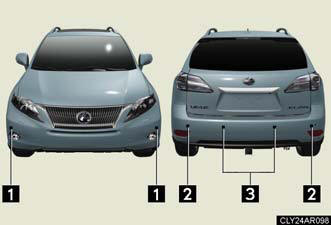
1. Front corner sensors.
2. Rear corner sensors.
3. Rear center sensors.
Setting the intuitive parking assist mode
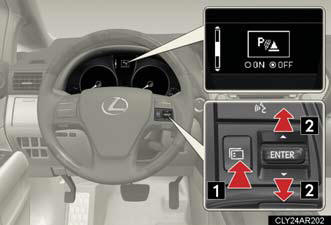
1. Press the menu switch.
The multi-information display
will change modes to electronic
features control mode.
2. Press the “ENTER” switch
upwards or downwards until
the intuitive parking assist
mark appears in the multiinformation
display.
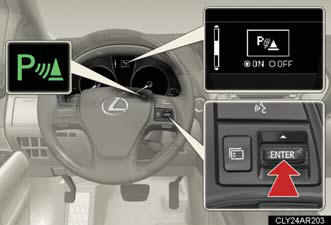
Press the “ENTER” switch to
change to “ON”.
The intuitive parking assist indicator
will be displayed.
Each pressing of the switch
turns the intuitive parking assist
on and off.
When on, the buzzer sounds to
inform the driver that the system
is operational.
Press the menu switch to
change to the normal display.
Display
When the sensors detect an obstacle, a graphic is shown on the
multiinformation
display depending on the position and distance to the obstacle.
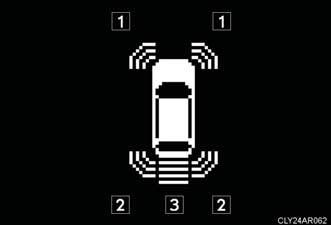
1. Front corner sensor operation.
2. Rear corner sensor operation.
3. Rear center sensor operation.
The distance display and buzzer
When a sensor detects an obstacle, the direction of and the approximate
distance to the obstacle are displayed and the buzzer sounds.
The site of the obstacle will flash (detection level 4 only).
Front corner sensors
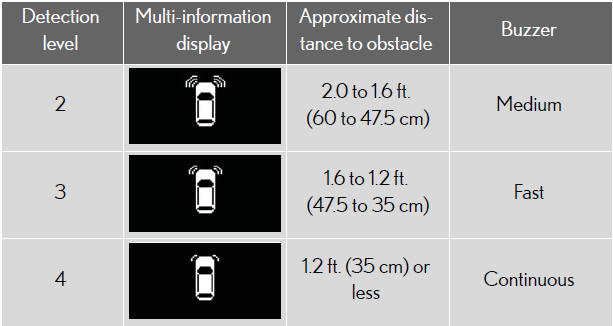
Rear corner sensors
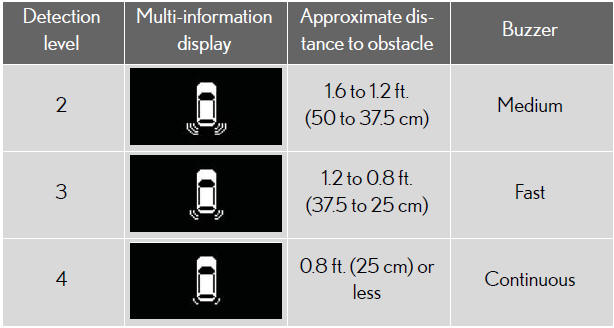
Rear center sensors
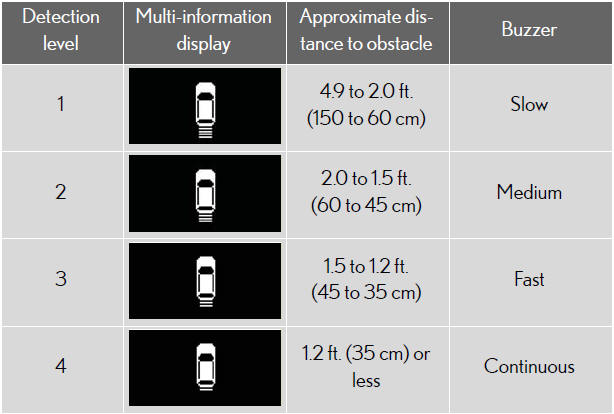
Detection range of the sensors
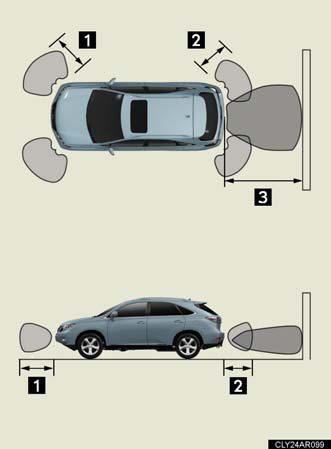
1. Approximately 2.0 ft. (60 cm).
2. Approximately 1.6 ft. (50 cm).
3. Approximately 4.9 ft. (150 cm).
The diagram shows the detection
range of the sensors. Note that the
sensors cannot detect obstacles
that are extremely close to the
vehicle.
The range of the sensors may
change depending on the shape of
the object etc.
The intuitive parking assist can be operated when
Front corner sensors:
• The “POWER” switch is in ON mode.
• The shift lever is in a position other than P.
• The vehicle speed is less than about 6 mph (10 km/h).
Rear corner and center sensors:
• The “POWER” switch is in ON mode.
• The shift lever is in R.
Sensor detection information
Certain vehicle conditions and the surrounding environment may affect the
ability of a sensor to correctly detect an obstacle. Particular instances where
this
may occur are listed below.
• There is dirt, snow or ice on a sensor.
• A sensor is frozen.
• A sensor is covered in any way.
• The vehicle is leaning considerably to one side.
• On an extremely bumpy road, on an incline, on gravel, or on grass
• The vicinity of the vehicle is noisy due to vehicle horns, motorcycle engines,
air brakes of large vehicles, or other loud noises producing ultrasonic waves.
• There is another vehicle equipped with parking assist sensors in the vicinity.
• A sensor is coated with a sheet of spray or heavy rain.
• The vehicle is equipped with a fender pole or radio antenna.
• Towing eyelets are installed.
• A bumper or sensor receives a strong impact.
• The vehicle is approaching a tall or right-angled curb.
• In harsh sunlight or intense cold weather.
• A non-genuine Lexus suspension (lowered suspension, etc.) is installed.
In addition to the examples above, there are instances in which, because of
their
shapes, signs and other objects may be judged by a sensor to be closer than they
are.
The shape of the obstacle may prevent a sensor from detecting it. Pay
particular
attention to the following obstacles:
• Wires, fences, ropes, etc.
• Cotton, snow and other materials that absorb sound waves
• Sharply-angled objects
• Low obstacles
• Tall obstacles with upper sections projecting outwards in the direction of
your
vehicle
Certification (Canada only)
This ISM device complies with Canadian ICES-001.
Customization
Settings (e.g. buzzer volume) can be changed.
CAUTION:
Caution when using the intuitive parking assist
Observe the following precautions.
Failing to do so may result in the vehicle being unable to be driven safely and
possibly
cause an accident.
Do not use the sensor at speeds in excess of 6 mph (10 km/h).
Do not attach any accessories within the sensor range.
NOTICE:
Notes when washing the vehicle
Do not apply intensive bursts of water or steam to the sensor area.
Doing so may result in the sensor malfunctioning.
Conditions possibly indicating system malfunctions
If any of the following occurs, the system may be malfunctioning due to a sensor
failure
etc. Have the vehicle inspected by your Lexus dealer.
The buzzer does not sound when the intuitive parking assist mode is set.
The sensor operation display flashes and the buzzer sounds even when no
obstacle
is detected.
An area of the sensors is hit or subjected to a strong impact.
Either bumper is hit.
The sensor operation display remains on even though no buzzer sounds.
Electronically modulated air suspension
The electronically modulated air suspension allows the driver to control
vehicle height in order to adjust driving conditions.
Select the desired height with the height selector switch.
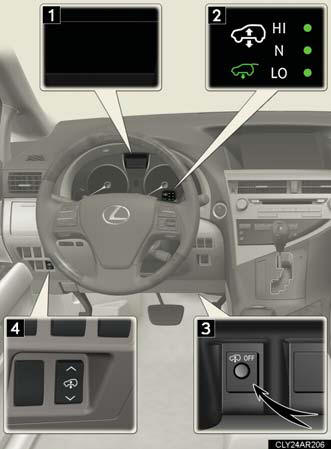
1. Multi-information display.
2. Electronically modulated air
suspension indicator.
3. Height control off button.
4. Height selector switch
(driver’s side instrument
panel).
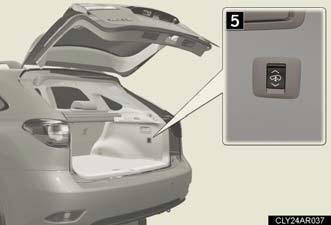
5. Height selector switch (luggage
compartment).
Selecting vehicle height
Height modes
“HI” mode: For driving on bumpy roads.
1.2 in. (30 mm) higher than the normal height.
“HI” mode cannot be selected when vehicle speed exceeds 19 mph
(30 km/h).
“N” mode: For ordinary driving.
Normal height.
“LO” mode: For sporty driving.
Vehicle front: 0.8 in. (20 mm) lower than the normal height.
Vehicle rear: 0.2 in. (5 mm) lower than the normal height.
Luggage mode: For easy entry/exit and easy luggage loading/
unloading.
1.2 in. (30 mm) lower than the normal height.
Height selector switch
- Press the height selector switch for approximately 1 second.
Driver's side instrument panel
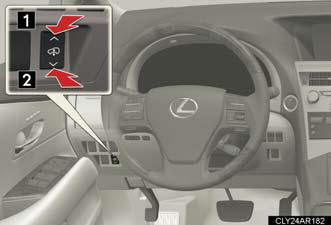
1. Higher.
Pressing this switch while the vehicle
is in luggage mode changes the
vehicle height to that of “N” mode.
2. Lower.
Pressing the switch while the vehicle
is in “LO” mode changes the
vehicle height to that of luggage
mode.
- Luggage compartment.
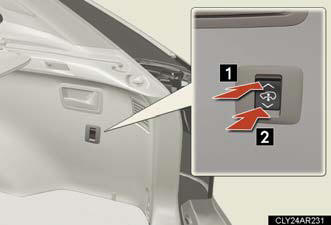
1. Higher.
Pressing this switch while the vehicle
is in luggage mode changes the
vehicle height to that of “N” mode.
2. Lower.
Pressing this switch while the vehicle
is in “N” mode changes the
vehicle height to that of luggage
mode, not “LO” mode.
Electronically modulated air suspension indicator
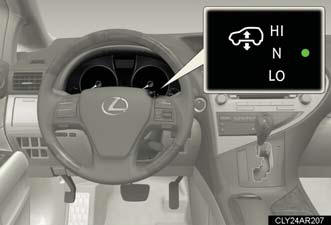
The indicator for the selected
mode will come on.
The indicator will flash while the
vehicle height is being changed to
the height of the selected mode.
Disabling the height control
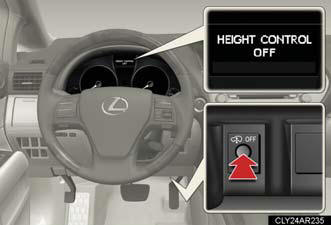
Press the height control off button
while the vehicle is stopped. A
message will appear on the multiinformation
display, and vehicle
height will be fixed in the current
mode.
When vehicle speed exceeds 19
mph (30 km/h), the electronically
modulated air suspension is reenabled
automatically.
Operating conditions
After stopping the hybrid system, the vehicle will remain lowered for a
maximum of
60 seconds.
Height selector switch (driver's side instrument panel)
• While the hybrid system is operating, any vehicle height mode can be
selected.
• Luggage mode can only be selected when the shift lever is in the P position.
Height selector switch (luggage compartment)
• When the hybrid system is operating and the shift lever is in the P position,
any
vehicle height other than “LO” mode can be selected.
• When the “POWER” switch is turned off, the vehicle height can only be lowered
(only the ‚Äú∨‚Äù side of the switch can be operated).
This switch can only be operated when the back door is open.
Height control off button
When the vehicle is stopped with the “POWER” switch in ON mode, vehicle
height control can be disabled/re-enabled.
When changing vehicle height modes
Before operating the height selector switch to raise/lower the vehicle
height,
ensure that there are no objects in the surrounding area that could damage the
vehicle.
When “N” mode is selected
During high speed driving, the vehicle height will automatically change to
that of
“LO” mode.
When “HI” mode is selected
The vehicle height will change to that of “N” mode when vehicle speed reaches
31
mph (50 km/h) or when vehicle speed has exceeded 19 mph (30 km/h) for
approximately 10 seconds. Even if vehicle speed is then reduced to under 19 mph
(30 km/h), height will not return to “HI” mode.
When “LO” mode is selected
The vehicle height will change to that of “N” mode when the hybrid system is
restarted.
When luggage mode is selected
If the vehicle begins to move while still in luggage mode, the vehicle will
automatically
change to “N” mode once speed exceeds 5 mph (8 km/h). Even if vehicle
speed is reduced below 5 mph (8 km/h), the vehicle height will not automatically
return to luggage mode.
Operating sound of the air suspension
When the vehicle height is lowered, such as when entering and loading the
vehicle,
or when the height selector switch is operated, the sound of the compressor
operating
or the mode changing may be heard. This does not indicate a malfunction.
Automatic leveling function
Regardless of the number of occupants and the luggage load, vehicle height in
any
mode is always adjusted to a fixed height by the automatic leveling function.
Vehicle height mode change time
If the height control is operated continuously to lower the vehicle, the
suspension
air tank may become full, causing operation of the vehicle height lowering
control to become slow.
To protect the compressor, the system will only raise the vehicle for a total
of
100 consecutive seconds. If it takes longer than this to reach the selected
height, operation may be suspended shortly and then restart. However, it may
not be possible to change the vehicle's height mode at this time.
The electronically modulated air suspension will not operate when
The vehicle height control may not be able to change modes when the vehicle
runs
over a high curb or other rugged surfaces where the suspension is stretched.
CAUTION:
The electronically modulated air suspension must be disabled when
The electronically modulated air suspension must be disabled in the following
situations
as vehicle height may change, resulting in accidental damage:
Any of the wheels is stuck in a ditch.
It is necessary to jack up the vehicle.
It is necessary to tow the vehicle with part of it lifted.
When connecting/disconnecting a trailer
For safety, stop the hybrid system if necessary.
NOTICE:
“HI” mode
“HI” mode should be used for off-road driving. As the vehicle's center of
gravity is
higher in this setting, the vehicle may become unstable if an abrupt turn is
made.
Do not select “HI” mode when loading cargo on the roof luggage carrier. This
may result in a loss of control or vehicle rollover.
Do not select “LO” mode when driving on bumpy roads.
If the underbody of the vehicle touches a rugged road surface, the vehicle may
be
damaged. Also be careful when driving while the vehicle is automatically
returning
from luggage or “LO” mode to “N” mode.
Automatic return to “N” mode
In the following situations, the height of the vehicle will automatically
increase. Be
careful in any place where overhead space is limited.
The vehicle begins to move while still in luggage mode.
The hybrid system is restarted while the vehicle is in “LO” mode.
Vehicle height while parked
If the temperature changes or the vehicle is parked for a long time, the vehicle
height may decrease.
Rear view monitor system (rear view mirror-attached type)
The rear view monitor system assists the driver by displaying an image of
the area behind the vehicle. The image is displayed in reverse on the
screen. This reversed image is a similar image to the one on the inside rear
view mirror.
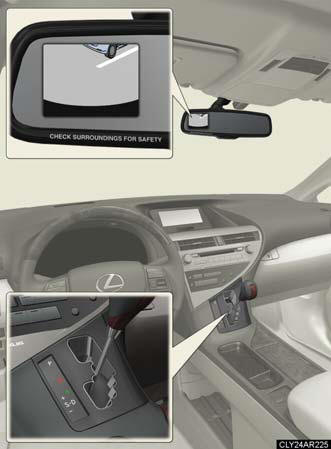
The rear view image is displayed
when the shift lever is in the R
position.
• If the shift lever is shifted out
of R, the screen is turned off.
• The screen remains on for
approximately 5 minutes.
The rear view monitor system can be operated when
The “POWER” switch is in ON mode and the back door is fully closed.
Switching the screen on/off
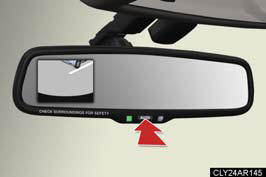
When the screen is displayed, press the
“AUTO” button on the inside rear view mirror
to switch the screen on/off.
Screen on: Green indicator comes on.
Screen off: Orange indicator comes on.
The auto anti-glare inside rear view mirror
will revert to the screen on each time the
“POWER” switch is turned to ON mode.
Displayed area
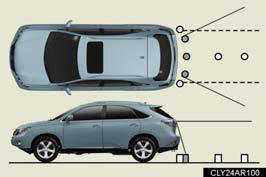
The area covered by the camera is limited.
Objects that are close to either corner of
the bumper or under the bumper cannot
be seen on the screen.
The area displayed on the screen may vary
according to vehicle orientation or road
conditions.
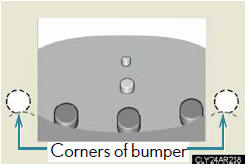
Rear view monitor system camera
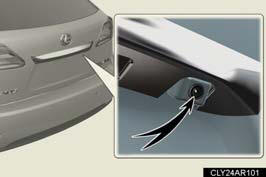
In the following cases, it may become difficult
to see the images on the screen, even
when the system is functioning correctly:
The vehicle is in a dark area, such as at
night.
The temperature near the lens is
extremely high or low.
Water droplets are on the camera lens
or humidity is high, such as when it
rains.
The camera has scratches or dirt on it
Foreign matter, such as snow or mud,
adheres to the camera lens.
The sun or headlights are shining
directly into the camera lens.
Smear effect
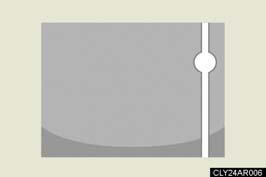
If a bright light, such as sunlight reflected
off the vehicle body, is picked up by the
camera, a smear effect* characteristic to
the camera may occur.
*: Smear effect ⎯ A phenomenon that
occurs when a bright light is picked up by
the camera; when transmitted by the
camera, the light source appears to have
a vertical streak above and below it.
CAUTION:
When using the rear view monitor system, observe the following precautions to
avoid an accident that could result in death or serious injuries:
Never depend solely on the monitor system when reversing.
Always check visually and with the mirrors to confirm your intended path is
clear.
Depicted distances between objects and flat surfaces differ from actual
distances.
Conditions which may affect the rear view monitor system
If the back of the vehicle has been hit, the camera’s position and mounting
angle
may have changed. Have the vehicle inspected by your Lexus dealer.
Rapid temperature changes, such as when hot water is poured on the vehicle in
cold weather, may cause the system to function abnormally.
If the camera lens is dirty, it cannot transmit a clear image. Rinse with
water and
wipe with a soft cloth. If extremely dirty, wash with a mild cleanser and rinse.
The displayed image may be darker and moving images may be slightly distorted
when the system is cold.
As the camera is of water proof construction, do not detach, disassemble or
modify it. This may cause incorrect operation.
Do not allow organic solvent, car wax, window cleaner or glass coating to
adhere
to the camera. If this happens, wipe it off as soon as possible.
Use your own eyes to confirm the vehicle's surroundings, as the displayed
image
may become faint or dark, and moving images will be distorted, or not entirely
visible when the outside temperature is low. When backing up, be sure to check
behind and all around the vehicle with your own eyes and the vehicle's mirrors.
Driving assist systems
To help enhance driving safety and performance, the following systems
operate automatically in response to various driving situations. Be aware,
however, that these systems are supplementary and should not be relied
upon too heavily when operating the vehicle.
ABS (Anti-lock Brake System)
Helps to prevent wheel lock when the brakes are applied suddenly, or if
the brakes are applied while driving on a slippery road surface
Brake assist
Generates an increased level of braking force after the brake pedal is
depressed, when the system detects a panic stop situation
VSC (Vehicle Stability Control)
Helps the driver to control skidding when swerving suddenly or turning on
slippery road surfaces
TRAC (Traction Control)
Maintains drive power and helps to prevent any of the drive wheels from
spinning when the vehicle is started or accelerated on a slippery road surface
EPS (Electric Power Steering)
Employs an electric motor to reduce the amount of effort needed to turn
the steering wheel
Active stabilizer suspension system (if equipped)
Reduces sway when cornering according to vehicle conditions such as
steering wheel movement and vehicle speed, in order to maintain a stable
vehicle posture
VDIM (Vehicle Dynamics Integrated Management)
Provides integrated control of the ABS, brake assist, TRAC, VSC, hill-start
assist control, and EPS systems.
Maintains vehicle stability when swerving on slippery road surfaces by
controlling the brakes and hybrid system output.
When the VSC/TRAC systems are operating
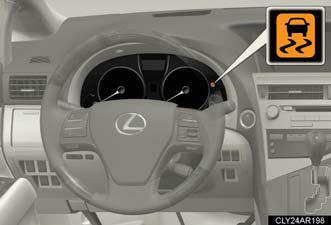
If the vehicle is in danger of slipping
or if any of the drive wheels
spins, the slip indicator light flashes
to indicate that the VSC/TRAC
systems are operating.
A buzzer (intermittent) sounds to
indicate that VSC is operating.
Disabling TRAC and/or VSC systems
If the vehicle gets stuck in fresh snow or mud, the TRAC/VSC systems
may reduce power from the hybrid system to the wheels. You may need
to turn the system off to enable you to rock the vehicle in order to free it.
Turning off the TRAC system only
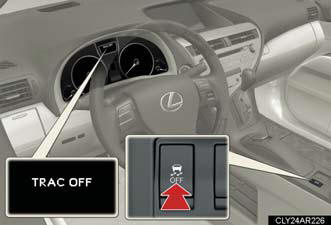
To turn the TRAC system off,
quickly press and release the button.
A message will be shown on the
multi-information display.
Press the button again to turn the
system back on.
Turning off both TRAC and VSC systems
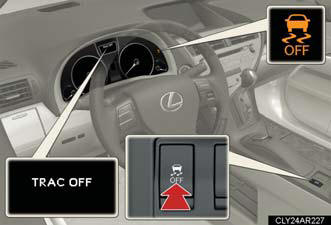
To turn the TRAC and VSC systems
off, press and hold the button
for more than 3 seconds while the
vehicle is stopped.
A message will be shown on the
multi-information display and VSC
off indicator light will come on.
Press the button again to turn the
systems back on.
Sounds and vibrations caused by the ABS, VSC, TRAC and brake assist
A sound may be heard from the engine compartment when the hybrid system is
started or just after the vehicle begins to move. This sound does not indicate
that
a malfunction has occurred in any of these systems.
Any of the following conditions may occur when the above systems are
operating.
None of these indicates that a malfunction has occurred.
• Vibrations may be felt through the vehicle body and steering.
• A motor sound may be heard after the vehicle comes to a stop.
• The brake pedal may pulsate slightly after the ABS is activated.
• The brake pedal may move down slightly after the ABS is activated.
EPS operation sound
When the steering wheel is operated, a motor sound (whirring sound) may be
heard. This does not indicate a malfunction.
Reactivation of the TRAC /VSC systems
Turning off the hybrid system after turning off the TRAC/VSC systems will
automatically
reactivate them.
Reactivation of the TRAC system linked to vehicle speed
When only the TRAC system is turned off, the TRAC system will turn on when
vehicle
speed increases. However, when both TRAC and VSC systems are turned off,
the systems will not turn on even when vehicle speed increases.
Reduced effectiveness of the EPS system
The effectiveness of the EPS system is reduced to prevent the system from
overheating
when there is frequent steering input over an extended period of time. The
steering wheel may feel heavy as a result. Should this occur, refrain from
excessive
steering input or stop the vehicle and turn the hybrid system off. The EPS
system
should return to normal within 10 minutes.
If the slip indicator comes on
It may indicate a malfunction in the VSC or TRC function.
Contact your Lexus dealer.
CAUTION:
The ABS does not operate effectively when
Tires with inadequate gripping ability are used (such as excessively worn
tires on
a snow covered road).
The vehicle hydroplanes while driving at high speed on a wet or slick road.
Stopping distance when the ABS is operating will exceed that of normal
conditions
The ABS is not designed to shorten the vehicle’s stopping distance. Always
maintain
a safe distance from the vehicle in front of you in the following situations:
When driving on dirt, gravel or snow-covered roads.
When driving with tire chains.
When driving over bumps in the road.
When driving over roads with potholes or roads with uneven surfaces.
TRAC may not operate effectively when
Directional control and power may not be achievable while driving on slippery
road
surfaces, even if the TRAC system is operating.
Do not drive the vehicle in conditions where stability and power may be lost.
CAUTION:
When the VSC is activated
The slip indicator light flashes and a warning buzzer sounds. Always drive
carefully.
Reckless driving may cause an accident. Exercise particular care when the
indicator
light flashes and a buzzer sounds.
When the TRAC/VSC systems are turned off
Be especially careful and drive at a speed appropriate to the road conditions.
As
these are the systems to ensure vehicle stability and driving force, do not turn
the
TRAC/VSC systems off unless necessary.
Replacing tires
Make sure that all tires are of the same size, brand, tread pattern and total
load
capacity. In addition, make sure that the tires are inflated to the recommended
tire
inflation pressure level.
The ABS and VSC systems will not function correctly if different tires are
installed
on the vehicle.
Contact your Lexus dealer for further information when replacing tires or
wheels.
Handling of tires and suspension
Using tires with any kind of problem or modifying the suspension will affect the
driving
assist systems, and may cause a system malfunction.
Hill-start assist control
Hill-start assist control helps to prevent the vehicle from rolling
backwards
when starting on an incline or slippery slope.
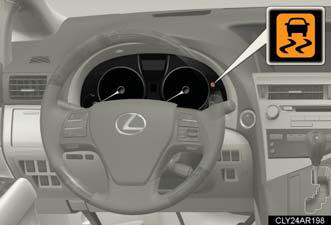
To engage hill-start assist control,
further depress the brake
pedal when the vehicle is
stopped completely.
A buzzer will sound once to
indicate the system is activated.
The slip indicator will also start
flashing.
Hill-start assist control can be operated when
l The shift lever is in a position other than P.
The parking brake is not applied.
The accelerator pedal is not depressed.
Hill-start assist control
While hill-start assist control is operating, the brakes remain automatically
applied after the driver releases the brake pedal. The stop lights and the high
mounted stoplight turn on.
Hill-start assist control operates for about 2 seconds after the brake pedal
is
released.
If the slip indicator does not flash and the buzzer does not sound when the
brake
pedal is further depressed, slightly reduce the pressure on the brake pedal (do
not allow the vehicle to roll backward) and then firmly depress it again. If the
system
still does not operate, check if the operating conditions explained above
have been met.
Hill-start assist control buzzer
When hill-start assist control is activated, the buzzer will sound once.
In the following situations, hill-start assist control will be canceled and
the
buzzer will sound twice.
• No attempt is made to drive the vehicle within approximately 2 seconds of
releasing the brake pedal.
• The shift lever is moved to P.
• The parking brake is applied.
• The brake pedal is depressed again.
• The brake pedal has been depressed for more than approximately 3 minutes.
If the slip indicator comes on
It may indicate a malfunction in the system. Contact your Lexus dealer.
CAUTION:
Hill-start assist control
Do not overly rely on hill-start assist control. Hill-start assist control may
not operate
effectively on extremely steep inclines or roads covered in ice.
Unlike the parking brake, hill-start assist control is not intended to hold
the vehicle
stationary for an extended period of time. Do not attempt to use hill-start
assist control to hold the vehicle on an incline for an extended period of time,
as
doing so may lead to an accident.
Pre-Collision System
When the radar sensor detects an unavoidable frontal collision, safety
systems
such as the brakes and seat belts are automatically engaged in an
attempt to lessen vehicle damage.
Pre-collision seat belts (front seat belts only)
If the pre-collision sensor detects that a collision is unavoidable, the
precollision
system will retract the seat belt before the collision occurs.
The same will happen if the driver makes an emergency braking or loses
control of the vehicle.
However, the system will not operate in the event of skidding when the
TRAC/VSC systems are disabled.
Pre-collision brake assist
When there is a high possibility of a frontal collision, the system applies
greater braking force in relation to how strongly the brake pedal is
depressed.
Radar sensor
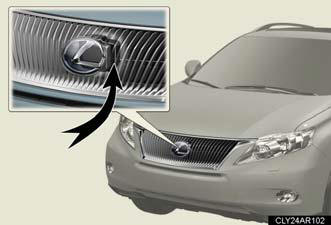
The radar sensor detects vehicles
or other obstacles on or near the
road ahead and determines
whether a collision is imminent
based on the position, speed, and
heading of the obstacles.
The pre-collision system is operational when
Pre-collision seat belts linked to the radar sensor
• Vehicle speed is greater than about 3 mph (5 km/h).
• The speed at which your vehicle is approaching the obstacle or oncoming
vehicle is greater than about 18 mph (30 km/h).
• The front occupants are wearing a seat belt.
Pre-collision seat belts in the event of sudden braking or skidding
• Vehicle speed is greater than about 18 mph (30 km/h).
• The system detects sudden braking or skidding.
• The front occupants are wearing a seat belt.
Pre-collision brake assist
• Vehicle speed is greater than about 18 mph (30 km/h).
• The speed at which your vehicle is approaching the obstacle or the vehicle
running ahead of you is greater than about 18 mph (30 km/h).
• The brake pedal is depressed.
Conditions that may trigger the system even if there is no danger of collision
When there is an object by the roadside at the entrance to a curve.
When passing an oncoming vehicle on a curve.
When driving over a narrow iron bridge.
When there is a metal object on the road surface.
When driving on an uneven road surface.
When passing an oncoming vehicle on a left-turn.
When your vehicle rapidly closes on the vehicle in front.
When the system is activated in the situations described above, there is also a
possibility
that the seat belts will retract quickly and the brakes will be applied with a
force
greater than normal. When the seat belt is locked in the retracted position,
stop the
vehicle in a safe place, release the seat belt and refasten it.
Obstacles not detected
The sensor cannot detect plastic obstacles such as traffic cones. There may
also be
occasions when the sensor cannot detect pedestrians, animals, bicycles,
motorcycles,
trees, or snowdrifts.
When there is a malfunction in the system
Warning lights and/or warning messages will turn on or flash.
Certification
- For vehicles sold in U.S.A.
FCC ID: HYQDNMWR005
This device complies with Part 15 of the FCC Rules. Operation is subject to the
following
two conditions: (1) this device may not cause harmful interference, and (2)
this device must accept any interference received, including interference that
may
cause undesired operation.
FCC WARNING
Changes or modifications not expressly approved by the party responsible for
compliance could void the user's authority to operate the equipment.
Radio frequency radiation exposure Information:
This equipment complies with FCC radiation exposure limits set forth for an
uncontrolled
environment.
This equipment should be installed and operated with minimum distance of 20 cm
between the radiator and your body.
This transmitter must not be co-located or operating in conjunction with any
other
antenna or transmitter.
- For vehicles sold in Canada.
Operation is subject to the following two conditions: (1) this device may not
cause
interference, and (2) this device must accept any interference, including
interference
that may cause undesired operation of the device.
CAUTION:
Limitations of the pre-collision system
Do not rely on the pre-collision system. Always drive safely, taking care to
observe
your surroundings and checking for any obstacles or other road hazards.
When the sensor may not be correctly detecting the vehicle ahead
Apply the brakes as necessary in any of the following situations:
When water or snow thrown up by the surrounding vehicles hinders the
functioning
of the sensor.
When your vehicle is pointing upwards (caused by a heavy load in the luggage
compartment etc.).
Vehicles that cut in suddenly.
Vehicles with small rear ends (trailers with no load on board etc.).
Motorcycles traveling in the same lane.
Handling the radar sensor
Observe the following to ensure the pre-collision system can function
effectively:
Keep the sensor and front grille clean at all times.
Clean the sensor and front grille with a soft cloth so you do not mark or damage
them.
Do not subject the sensor or surrounding area to a strong impact.
If the sensor moves even slightly off position, the system may malfunction. If
the
sensor or surrounding area is subject to a strong impact, always have the area
inspected and adjusted by your Lexus dealer.
Do not disassemble the sensor.
Do not attach accessories or stickers to the sensor, grille or surrounding
area.
Do not modify or paint the sensor and grille cover.
See also:
Destination search by Home
1. Push the “DEST” button.
2. Touch “Go Home”.
The screen changes and displays the map location for home and the route preference.
(See “Starting route guidance” on page 83.) If home ...
Armrest
►Front
Lift the lid while pulling up
the upper lever to release the
lock.
►Rear
Collapse the armrest while
pulling the strap. ...
Audio system
Vehicles with a navigation system
Refer to the “Navigation System Owner’s Manual”.
Vehicles without a navigation system
CD player with a changer and AM/FM radio
- Using cellular phon ...
